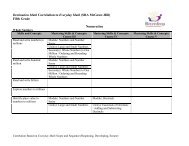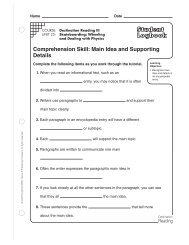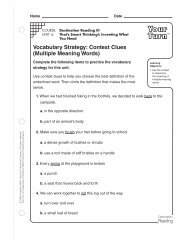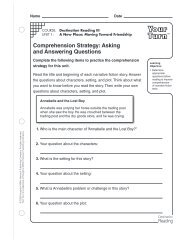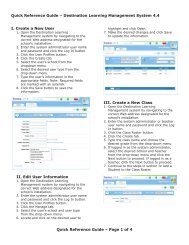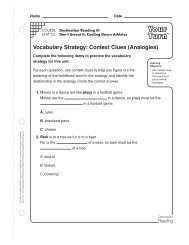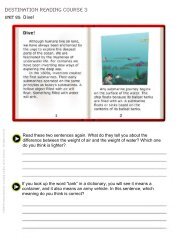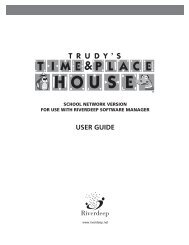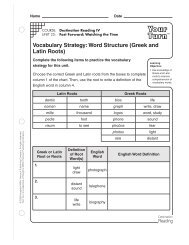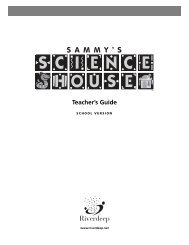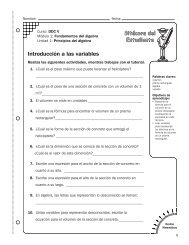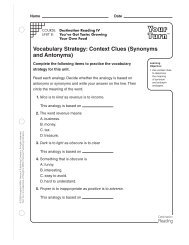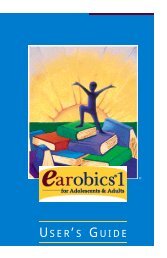Destination Math⢠Mastering Skills & Concepts (MSC)
Destination Math⢠Mastering Skills & Concepts (MSC)
Destination Math⢠Mastering Skills & Concepts (MSC)
You also want an ePaper? Increase the reach of your titles
YUMPU automatically turns print PDFs into web optimized ePapers that Google loves.
<strong>Destination</strong> Math <strong>Mastering</strong> <strong>Skills</strong> & <strong>Concepts</strong> (<strong>MSC</strong>) Page 2 of 4AlignmentTEKS Grade 2 Math Objectives to <strong>Destination</strong> Math—<strong>MSC</strong> I-II-IIIK = Key lesson – supports the TEKS that the student must know and be able to demonstrate at this grade levelF = Foundational lesson – prerequisite concepts for TEKS that a student must know and be able to demonstrate at thisgrade levelP = Partially covered lesson – only addresses part of the TEKS listedA = Accelerated lesson – advanced and is appropriate for acceleration of this TEKSPatterns, Relationships, & Algebraic Thinking.2.5C Use patterns and relationships to developstrategies to remember basic addition andsubtraction facts. Determine patterns in relatedaddition and subtraction number sentences(including fact families) such as 8 + 9 = 17, 9 +8 = 17, 17 - 8 = 9, and 17 - 9 = 8.2.6A Generate a list of paired numbers based on areal-life situation such as number of tricyclesrelated to number of wheels.2.6B Identify patterns in a list of related number pairsbased on a real-life situation and extend the list.2.6C Identify, describe, and extend repeating andadditive patterns to make predictions and solveproblems.Geometry and Spatial Reasoning.2.7A Describe attributes (the number of vertices,faces, edges, sides) of two- and threedimensionalgeometric figures such ascircles,polygons,spheres,cones, cylinders,prisms and pyramids2.7B Use attributes to describe how 2 twodimensionalgeometric figures are alike anddifferent2.7C Cut two-dimensional geometric figures apartand identify the new geometric figures formed.2.8 Use whole numbers to locate and name pointson a line.Measurement.2.9A Identify concrete models that approximatestandard units of length and use them tomeasure length.2.9B Select a non-standard unit of measure such assquare tiles to determine the area of a twodimensionalsurface2.9C Select a non-standard unit of measure such asa bathroom cup or a jar to determine thecapacity of a given container2.9D Select a non-standard unit of measure such asbeans and marbles to determine theweight/mass of a given object.Course.Module.Unit.Session -- Session DescriptionI.4.1.2 – Number Patterns (K)II.2.1.1 – Sums less than 100 (F)II.2.2.1 – Repeated addition and arrays (K – screen 1)III.2.1.1 – Whole Number Sums (A – uses four and five digitnumbers)II.4.1.1 – Number patterns & properties (A/screen2)II.4.1.1 – Number patterns & properties(A/screen2)I.4.1.2 – Number patterns (F)II.2.2.1 – Repeated addition & arrays (K)II.2.2.2 – Skip counting to show multiplication (K)II.4.1.1 – Number patterns and properties (A/ screen 2)I.3.2.1 – Triangles & rectangles (F –screen 2)I.3.2.2 – Three-dimensional shapes (F)I.4.1.1 – Shapes (F- screen 2)II.3.1.1 – Area (K)II.2.1.2 – Estimating & finding sums less than 1000 (A)II.2.1.4 – Estimating & finding differences within 1000 (A)II.2.2.2 – Skip counting to show multiplication (A) (All lessonsshould be whole group)I.3.1.1 – Length (K – screen 2 & practice questions 5 and 6)II.3.1.1 – Area (K)II.3.1.2 – Volume (A – uses standard units)I.3.1.2 – Weight (P – does not use mass)2.10A Read a thermometer to gather data. II.3.2.3 – Temperature (K)2.10B Read and write times shown on analog and II.3.2.1 – Time (K)digital clocks using five-minute increments



